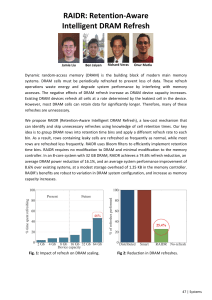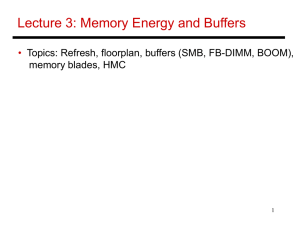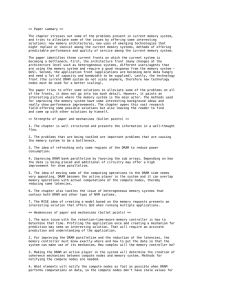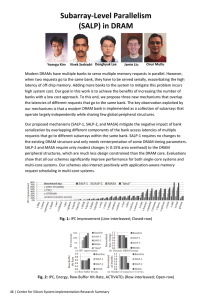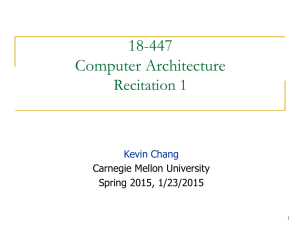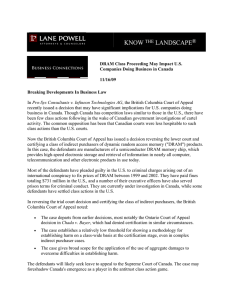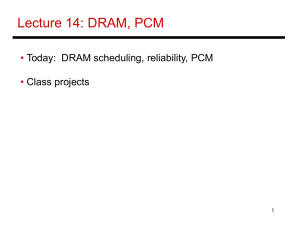18-447 Computer Architecture Lecture 25: Main Memory Wrap-Up Prof. Onur Mutlu
advertisement
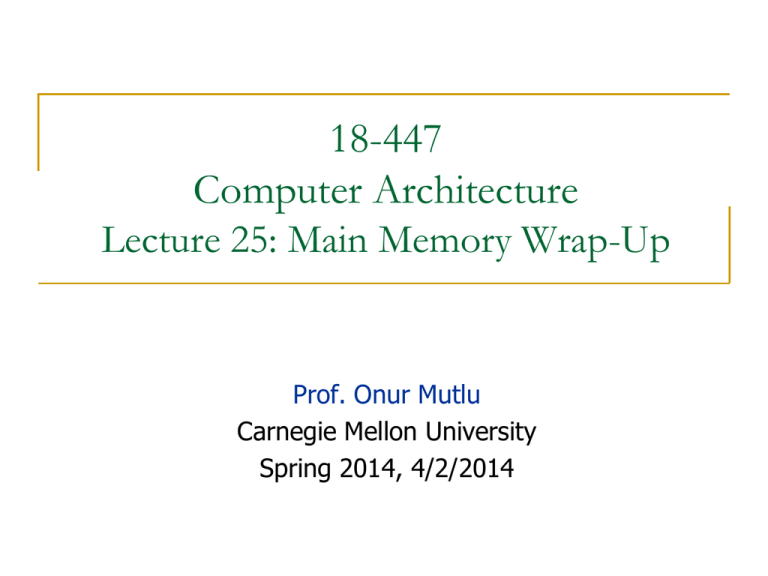
18-447
Computer Architecture
Lecture 25: Main Memory Wrap-Up
Prof. Onur Mutlu
Carnegie Mellon University
Spring 2014, 4/2/2014
Memory Interference and Scheduling
in Multi-Core Systems
Review: PAR-BS Pros and Cons
Upsides:
First scheduler to address bank parallelism destruction across
multiple threads
Simple mechanism (vs. STFM)
Batching provides fairness
Ranking enables parallelism awareness
Downsides:
Implementation in multiple controllers needs coordination for
best performance too frequent coordination since batching
is done frequently
Does not always prioritize the latency-sensitive applications
3
TCM:
Thread Cluster Memory Scheduling
Yoongu Kim, Michael Papamichael, Onur Mutlu, and Mor Harchol-Balter,
"Thread Cluster Memory Scheduling:
Exploiting Differences in Memory Access Behavior"
43rd International Symposium on Microarchitecture (MICRO),
pages 65-76, Atlanta, GA, December 2010. Slides (pptx) (pdf)
TCM Micro 2010 Talk
Throughput vs. Fairness
24 cores, 4 memory controllers, 96 workloads
Maximum Slowdown
Better fairness
17
15
System throughput bias
13
FCFS
11
FRFCFS
9
STFM
7
PAR-BS
Fairness bias
5
ATLAS
3
1
7
7.5
8
8.5
9
9.5
10
Weighted Speedup
Better system throughput
No previous memory scheduling algorithm provides
both the best fairness and system throughput
5
Throughput vs. Fairness
Throughput biased approach
Prioritize less memory-intensive threads
Fairness biased approach
Take turns accessing memory
Good for throughput Does not starve
thread A
less memory
intensive
thread B
thread C
higher
priority
starvation unfairness
thread C
thread A
thread B
not prioritized
reduced throughput
Single policy for all threads is insufficient
6
Achieving the Best of Both Worlds
higher
priority
thread
For Throughput
Prioritize memory-non-intensive threads
thread
thread
thread
thread
thread
thread
thread
For Fairness
Unfairness caused by memory-intensive
being prioritized over each other
• Shuffle thread ranking
Memory-intensive threads have
different vulnerability to interference
• Shuffle asymmetrically
7
Thread Cluster Memory Scheduling [Kim+ MICRO’10]
1. Group threads into two clusters
2. Prioritize non-intensive cluster
3. Different policies for each cluster
Memory-non-intensive
thread
thread
thread
thread
Non-intensive
cluster
Throughput
thread
thread
higher
priority
Prioritized
thread
higher
priority
Threads in the system
Memory-intensive
Intensive cluster
Fairness
8
Clustering Threads
αT
T
T = Total memory bandwidth usage
thread
thread
thread
thread
Non-intensive
cluster
thread
thread
Step1 Sort threads by MPKI (misses per kiloinstruction)
higher
MPKI
Intensive
cluster
α < 10%
ClusterThreshold
Step2 Memory bandwidth usage αT divides clusters
9
TCM: Quantum-Based Operation
Previous quantum Current quantum
(~1M cycles)
(~1M cycles)
Time
During quantum:
• Monitor thread behavior
1. Memory intensity
2. Bank-level parallelism
3. Row-buffer locality
Shuffle interval
(~1K cycles)
Beginning of quantum:
• Perform clustering
• Compute niceness of
intensive threads
10
TCM: Scheduling Algorithm
1. Highest-rank: Requests from higher ranked threads prioritized
• Non-Intensive cluster > Intensive cluster
• Non-Intensive cluster: lower intensity higher rank
• Intensive cluster: rank shuffling
2.Row-hit: Row-buffer hit requests are prioritized
3.Oldest: Older requests are prioritized
11
TCM: Throughput and Fairness
24 cores, 4 memory controllers, 96 workloads
Maximum Slowdown
Better fairness
16
FRFCFS
14
ATLAS
12
STFM
10
PAR-BS
8
TCM
6
4
7.5
8
8.5
9
9.5
10
Weighted Speedup
Better system throughput
TCM, a heterogeneous scheduling policy,
provides best fairness and system throughput
12
TCM: Fairness-Throughput Tradeoff
When configuration parameter is varied…
Maximum Slowdown
Better fairness
12
FRFCFS
10
ATLAS
STFM
8
PAR-BS
6
TCM
4
2
12
13
14
Adjusting
15
16
ClusterThreshold
Weighted Speedup
Better system throughput
TCM allows robust fairness-throughput tradeoff
13
TCM Pros and Cons
Upsides:
Provides both high fairness and high performance
Caters to the needs for different types of threads (latency vs.
bandwidth sensitive)
(Relatively) simple
Downsides:
Scalability to large buffer sizes?
Robustness of clustering and shuffling algorithms?
14
Other Ways of Handling Interference
Fundamental Interference Control Techniques
Goal: to reduce/control interference
1. Prioritization or request scheduling
2. Data mapping to banks/channels/ranks
3. Core/source throttling
4. Application/thread scheduling
16
Memory Channel Partitioning
Memory Channel Partitioning
Idea: Map badly-interfering applications’ pages to different
channels [Muralidhara+, MICRO’11]
Time Units
5
Core 0
App A
Core 1
App B
4
3
2
1
Channel 0
Bank 0
Bank 1
Bank 0
Bank 1
Channel 1
Conventional Page Mapping
Time Units
5
4
3
2
1
Core 0
App A
Core 1
App B
Channel 0
Bank 0
Bank 1
Bank 0
Bank 1
Channel 1
Channel Partitioning
Separate data of low/high intensity and low/high row-locality applications
Especially effective in reducing interference of threads with “medium” and
“heavy” memory intensity
Muralidhara et al., “Memory Channel Partitioning,” MICRO’11.
17
Memory Channel Partitioning (MCP) Mechanism
Hardware
1.
2.
3.
4.
5.
Profile applications
Classify applications into groups
Partition channels between application groups
Assign a preferred channel to each application
Allocate application pages to preferred channel
System
Software
18
Observations
Applications with very low memory-intensity rarely
access memory
Dedicating channels to them results in precious
memory bandwidth waste
They have the most potential to keep their cores busy
We would really like to prioritize them
They interfere minimally with other applications
Prioritizing them does not hurt others
19
Integrated Memory Partitioning and Scheduling (IMPS)
Always prioritize very low memory-intensity
applications in the memory scheduler
Use memory channel partitioning to mitigate
interference between other applications
Muralidhara et al., “Memory Channel Partitioning,” MICRO’11.
20
Fundamental Interference Control Techniques
Goal: to reduce/control interference
1. Prioritization or request scheduling
2. Data mapping to banks/channels/ranks
3. Core/source throttling
4. Application/thread scheduling
21
An Alternative Approach: Source Throttling
Manage inter-thread interference at the cores (sources),
not at the shared resources
Dynamically estimate unfairness in the memory system
Feed back this information into a controller
Throttle cores’ memory access rates accordingly
Whom to throttle and by how much depends on performance
target (throughput, fairness, per-thread QoS, etc)
E.g., if unfairness > system-software-specified target then
throttle down core causing unfairness &
throttle up core that was unfairly treated
Ebrahimi et al., “Fairness via Source Throttling,” ASPLOS’10, TOCS’12.
22
Fairness via Source Throttling (FST) [ASPLOS’10]
Interval 1
Interval 3
Time
⎧
⎪
⎨
⎪
⎩
FST
Interval 2
Slowdown
Estimation
Runtime
Unfairness
Evaluation
Unfairness Estimate
App-slowest
App-interfering
1- Estimating system unfairness
2- Find app. with the highest
slowdown (App-slowest)
3- Find app. causing most
interference for App-slowest
(App-interfering)
Dynamic
Request Throttling
if (Unfairness Estimate >Target)
{
1-Throttle down App-interfering
(limit injection rate and parallelism)
2-Throttle up App-slowest
}
23
Core (Source) Throttling
Idea: Estimate the slowdown due to (DRAM) interference
and throttle down threads that slow down others
Ebrahimi et al., “Fairness via Source Throttling: A Configurable
and High-Performance Fairness Substrate for Multi-Core
Memory Systems,” ASPLOS 2010.
Advantages
+ Core/request throttling is easy to implement: no need to
change the memory scheduling algorithm
+ Can be a general way of handling shared resource contention
Disadvantages
- Requires interference/slowdown estimations
- Thresholds can become difficult to optimize throughput loss
24
Fundamental Interference Control Techniques
Goal: to reduce/control interference
1. Prioritization or request scheduling
2. Data mapping to banks/channels/ranks
3. Core/source throttling
4. Application/thread scheduling
Idea: Pick threads that do not badly interfere with each
other to be scheduled together on cores sharing the memory
system
25
Handling Interference in Parallel Applications
Threads in a multithreaded application are inter-dependent
Some threads can be on the critical path of execution due
to synchronization; some threads are not
How do we schedule requests of inter-dependent threads
to maximize multithreaded application performance?
Idea: Estimate limiter threads likely to be on the critical path and
prioritize their requests; shuffle priorities of non-limiter threads
to reduce memory interference among them [Ebrahimi+, MICRO’11]
Hardware/software cooperative limiter thread estimation:
Thread executing the most contended critical section
Thread that is falling behind the most in a parallel for loop
26
Summary: Fundamental Interference Control Techniques
Goal: to reduce/control interference
1. Prioritization or request scheduling
2. Data mapping to banks/channels/ranks
3. Core/source throttling
4. Application/thread scheduling
Best is to combine all. How would you do that?
27
More on DRAM Controllers
DRAM Power Management
DRAM chips have power modes
Idea: When not accessing a chip power it down
Power states
Active (highest power)
All banks idle
Power-down
Self-refresh (lowest power)
State transitions incur latency during which the chip cannot
be accessed
29
Why are DRAM Controllers Difficult to Design?
Need to obey DRAM timing constraints for correctness
Need to keep track of many resources to prevent conflicts
There are many (50+) timing constraints in DRAM
tWTR: Minimum number of cycles to wait before issuing a read
command after a write command is issued
tRC: Minimum number of cycles between the issuing of two
consecutive activate commands to the same bank
…
Channels, banks, ranks, data bus, address bus, row buffers
Need to handle DRAM refresh
Need to manage power consumption
Need to optimize for performance (in the presence of constraints)
Reordering is not simple
Fairness and QoS needs complicates the scheduling problem
30
Many DRAM Timing Constraints
From Lee et al., “DRAM-Aware Last-Level Cache Writeback: Reducing
Write-Caused Interference in Memory Systems,” HPS Technical Report,
April 2010.
31
More on DRAM Operation
Kim et al., “A Case for Exploiting Subarray-Level Parallelism
(SALP) in DRAM,” ISCA 2012.
Lee et al., “Tiered-Latency DRAM: A Low Latency and Low
Cost DRAM Architecture,” HPCA 2013.
32
Self-Optimizing DRAM Controllers
Problem: DRAM controllers difficult to design It is difficult for
human designers to design a policy that can adapt itself very well
to different workloads and different system conditions
Idea: Design a memory controller that adapts its scheduling
policy decisions to workload behavior and system conditions
using machine learning.
Observation: Reinforcement learning maps nicely to memory
control.
Design: Memory controller is a reinforcement learning agent that
dynamically and continuously learns and employs the best
scheduling policy.
33
Ipek+, “Self Optimizing Memory Controllers: A Reinforcement Learning Approach,” ISCA 2008.
Self-Optimizing DRAM Controllers
Engin Ipek, Onur Mutlu, José F. Martínez, and Rich
Caruana,
"Self Optimizing Memory Controllers: A
Reinforcement Learning Approach"
Proceedings of the 35th International Symposium on
Computer Architecture (ISCA), pages 39-50, Beijing,
China,
June
2008.
Goal:
Learn to
choose
actions to maximize r0 + r1 + 2r2 + … ( 0 < 1)
34
Self-Optimizing DRAM Controllers
Dynamically adapt the memory scheduling policy via
interaction with the system at runtime
Associate system states and actions (commands) with long term
reward values
Schedule command with highest estimated long-term value in each
state
Continuously update state-action values based on feedback from
system
35
Self-Optimizing DRAM Controllers
Engin Ipek, Onur Mutlu, José F. Martínez, and Rich Caruana,
"Self Optimizing Memory Controllers: A Reinforcement Learning
Approach"
Proceedings of the 35th International Symposium on Computer Architecture
(ISCA), pages 39-50, Beijing, China, June 2008.
36
States, Actions, Rewards
❖ Reward function
• +1 for scheduling
Read and Write
commands
•
0 at all other
times
❖ State attributes
• Number of
reads, writes, and
load misses in
transaction queue
•
Number of pending
writes and ROB
heads waiting for
referenced row
•
Request’s relative
ROB order
❖ Actions
• Activate
• Write
• Read - load miss
• Read - store miss
• Precharge - pending
• Precharge - preemptive
• NOP
37
Performance Results
38
Self Optimizing DRAM Controllers
Advantages
+ Adapts the scheduling policy dynamically to changing workload
behavior and to maximize a long-term target
+ Reduces the designer’s burden in finding a good scheduling
policy. Designer specifies:
1) What system variables might be useful
2) What target to optimize, but not how to optimize it
Disadvantages
-- Black box: designer much less likely to implement what she
cannot easily reason about
-- How to specify different reward functions that can achieve
different objectives? (e.g., fairness, QoS)
39
DRAM Refresh
DRAM Refresh
DRAM capacitor charge leaks over time
The memory controller needs to refresh each row
periodically to restore charge
Read and close each row every N ms
Typical N = 64 ms
Downsides of refresh
-- Energy consumption: Each refresh consumes energy
-- Performance degradation: DRAM rank/bank unavailable while
refreshed
-- QoS/predictability impact: (Long) pause times during refresh
-- Refresh rate limits DRAM capacity scaling
41
DRAM Refresh: Performance
Implications of refresh on performance
-- DRAM bank unavailable while refreshed
-- Long pause times: If we refresh all rows in burst, every 64ms
the DRAM will be unavailable until refresh ends
Burst refresh: All rows refreshed immediately after one
another
Distributed refresh: Each row refreshed at a different time,
at regular intervals
42
Distributed Refresh
Distributed refresh eliminates long pause times
How else can we reduce the effect of refresh on
performance/QoS?
Does distributed refresh reduce refresh impact on energy?
Can we reduce the number of refreshes?
43
Refresh Today: Auto Refresh
Columns
Rows
BANK 0
BANK 1
BANK 2
BANK 3
Row Buffer
DRAM Bus
DRAM CONTROLLER
A batch of rows are
periodically refreshed
via the auto-refresh command
44
Refresh Overhead: Performance
46%
8%
Liu et al., “RAIDR: Retention-Aware Intelligent DRAM Refresh,” ISCA 2012.
45
Refresh Overhead: Energy
47%
15%
Liu et al., “RAIDR: Retention-Aware Intelligent DRAM Refresh,” ISCA 2012.
46
Problem with Conventional Refresh
Today: Every row is refreshed at the same rate
Observation: Most rows can be refreshed much less often
without losing data [Kim+, EDL’09]
Problem: No support in DRAM for different refresh rates per row
47
Retention Time of DRAM Rows
Observation: Only very few rows need to be refreshed at the
worst-case rate
Can we exploit this to reduce refresh operations at low cost?
48
Reducing DRAM Refresh Operations
Idea: Identify the retention time of different rows and
refresh each row at the frequency it needs to be refreshed
(Cost-conscious) Idea: Bin the rows according to their
minimum retention times and refresh rows in each bin at
the refresh rate specified for the bin
e.g., a bin for 64-128ms, another for 128-256ms, …
Observation: Only very few rows need to be refreshed very
frequently [64-128ms] Have only a few bins Low HW
overhead to achieve large reductions in refresh operations
Liu et al., “RAIDR: Retention-Aware Intelligent DRAM Refresh,” ISCA 2012.
49
RAIDR: Mechanism
1. Profiling: Profile the retention time of all DRAM rows
can be done at DRAM design time or dynamically
2. Binning: Store rows into bins by retention time
use Bloom Filters for efficient and scalable storage
1.25KB storage in controller for 32GB DRAM memory
3. Refreshing: Memory controller refreshes rows in different
bins at different rates
probe Bloom Filters to determine refresh rate of a row
50
1. Profiling
51
2. Binning
How to efficiently and scalably store rows into retention
time bins?
Use Hardware Bloom Filters [Bloom, CACM 1970]
Bloom, “Space/Time Trade-offs in Hash Coding with Allowable Errors”, CACM 1970.
52
Bloom Filter
[Bloom, CACM 1970]
Probabilistic data structure that compactly represents set
membership (presence or absence of element in a set)
Non-approximate set membership: Use 1 bit per element to
indicate absence/presence of each element from an element
space of N elements
Approximate set membership: use a much smaller number of
bits and indicate each element’s presence/absence with a
subset of those bits
Some elements map to the bits also mapped to other elements
Operations: 1) insert, 2) test, 3) remove all elements
Bloom, “Space/Time Trade-offs in Hash Coding with Allowable Errors”, CACM 1970.
53
Bloom Filter Operation Example
Bloom, “Space/Time Trade-offs in Hash Coding with Allowable Errors”, CACM 1970.
54
Bloom Filter Operation Example
55
Bloom Filter Operation Example
56
Bloom Filter Operation Example
57
Bloom Filter Operation Example
58
Benefits of Bloom Filters as Bins
False positives: a row may be declared present in the
Bloom filter even if it was never inserted
Not a problem: Refresh some rows more frequently than
needed
No false negatives: rows are never refreshed less
frequently than needed (no correctness problems)
Scalable: a Bloom filter never overflows (unlike a fixed-size
table)
Efficient: No need to store info on a per-row basis; simple
hardware 1.25 KB for 2 filters for 32 GB DRAM system
59
Use of Bloom Filters in Hardware
Useful when you can tolerate false positives in set
membership tests
See the following recent examples for clear descriptions of
how Bloom Filters are used
Liu et al., “RAIDR: Retention-Aware Intelligent DRAM
Refresh,” ISCA 2012.
Seshadri et al., “The Evicted-Address Filter: A Unified
Mechanism to Address Both Cache Pollution and Thrashing,”
PACT 2012.
60
3. Refreshing (RAIDR Refresh Controller)
61
3. Refreshing (RAIDR Refresh Controller)
Liu et al., “RAIDR: Retention-Aware Intelligent DRAM Refresh,” ISCA 2012.
62
RAIDR: Baseline Design
Refresh control is in DRAM in today’s auto-refresh systems
RAIDR can be implemented in either the controller or DRAM
63
RAIDR in Memory Controller: Option 1
Overhead of RAIDR in DRAM controller:
1.25 KB Bloom Filters, 3 counters, additional commands
issued for per-row refresh (all accounted for in evaluations)
64
RAIDR in DRAM Chip: Option 2
Overhead of RAIDR in DRAM chip:
Per-chip overhead: 20B Bloom Filters, 1 counter (4 Gbit chip)
Total overhead: 1.25KB Bloom Filters, 64 counters (32 GB DRAM)
65
RAIDR: Results and Takeaways
System: 32GB DRAM, 8-core; SPEC, TPC-C, TPC-H workloads
RAIDR hardware cost: 1.25 kB (2 Bloom filters)
Refresh reduction: 74.6%
Dynamic DRAM energy reduction: 16%
Idle DRAM power reduction: 20%
Performance improvement: 9%
Benefits increase as DRAM scales in density
66
DRAM Refresh: More Questions
What else can you do to reduce the impact of refresh?
What else can you do if you know the retention times of
rows?
How can you accurately measure the retention time of
DRAM rows?
Recommended reading:
Liu et al., “An Experimental Study of Data Retention Behavior
in Modern DRAM Devices: Implications for Retention Time
Profiling Mechanisms,” ISCA 2013.
67
We will likely not cover the following
slides in lecture. These are for your
benefit.
ATLAS Memory Scheduler
Yoongu Kim, Dongsu Han, Onur Mutlu, and Mor Harchol-Balter,
"ATLAS: A Scalable and High-Performance
Scheduling Algorithm for Multiple Memory Controllers"
16th International Symposium on High-Performance Computer Architecture (HPCA),
Bangalore, India, January 2010. Slides (pptx)
ATLAS HPCA 2010 Talk
Rethinking Memory Scheduling
A thread alternates between two states (episodes)
Outstanding
memory requests
Compute episode: Zero outstanding memory requests High IPC
Memory episode: Non-zero outstanding memory requests Low IPC
Time
Memory episode
Compute episode
Goal: Minimize time spent in memory episodes
70
How to Minimize Memory Episode Time
Prioritize thread whose memory episode will end the soonest
Minimizes time spent in memory episodes across all threads
Supported by queueing theory:
Shortest-Remaining-Processing-Time scheduling is optimal in
single-server queue
Outstanding
memory requests
Remaining length of a memory episode?
How much longer?
Time
71
Predicting Memory Episode Lengths
Outstanding
memory requests
We discovered: past is excellent predictor for future
Time
Attained service
PAST
Remaining service
FUTURE
Large attained service Large expected remaining service
Q: Why?
A: Memory episode lengths are Pareto distributed…
72
Pareto Distribution of Memory Episode Lengths
Pr{Mem. episode > x}
401.bzip2
Memory episode lengths of
SPEC benchmarks
Pareto distribution
The longer an episode has lasted
The longer it will last further
x (cycles)
Attained service correlates with
remaining service
Favoring least-attained-service memory episode
= Favoring memory episode which will end the soonest
73
Least Attained Service (LAS) Memory Scheduling
Our Approach
Queueing Theory
Prioritize the memory episode with
least-remaining-service
Prioritize the job with
shortest-remaining-processing-time
Remaining service: Correlates with attained service
Provably optimal
Attained service: Tracked by per-thread counter
Prioritize the memory episode with
least-attained-service
Least-attained-service (LAS) scheduling:
Minimize memory episode time
However, LAS does not consider
long-term thread behavior
74
Long-Term Thread Behavior
Thread 1
Thread 2
Long memory episode
Short memory episode
Short-term
thread behavior
>
Mem.
episode
priority
Long-term
thread behavior
<
priority
Compute
episode
Mem.
episode
Compute
episode
Prioritizing Thread 2 is more beneficial:
results in very long stretches of compute episodes
75
Short-term
thread behavior
Outstanding
memory requests
Quantum-Based Attained Service of a Thread
Time
Long-term
thread behavior
Outstanding
memory requests
Attained service
Quantum (millions of cycles)
…
Time
Attained service
We divide time into large, fixed-length intervals:
quanta (millions of cycles)
76
LAS Thread Ranking
During a quantum
Each thread’s attained service (AS) is tracked by MCs
ASi = A thread’s AS during only the i-th quantum
End of a quantum
Each thread’s TotalAS computed as:
TotalASi = α · TotalASi-1 + (1- α) · ASi
High α More bias towards history
Threads are ranked, favoring threads with lower TotalAS
Next quantum
Threads are serviced according to their ranking
77
ATLAS Scheduling Algorithm
ATLAS
Adaptive per-Thread Least Attained Service
Request prioritization order
1. Prevent starvation: Over threshold request
2. Maximize performance: Higher LAS rank
3. Exploit locality: Row-hit request
4. Tie-breaker: Oldest request
How to coordinate MCs to agree upon a consistent ranking?
78
System Throughput: 24-Core System
System throughput = ∑ Speedup
System
throughput
Systemthroughput
FCFS
FR_FCFS
STFM
PAR-BS
ATLAS
3.5%
16
5.9%
14
8.4%
12
9.8%
10
8
17.0%
6
4
1
2
4
8
16
Memory controllers
# of memory
controllers
ATLAS consistently provides higher system throughput than
all previous scheduling algorithms
79
System Throughput: 4-MC System
System
throughput
Systemthroughput
PAR-BS
14
12
10
8
6
4
2
0
ATLAS
10.8%
8.4%
4.0%
1.1%
4
3.5%
8
16
24
32
Cores
# of
cores
# of cores increases ATLAS performance benefit increases
80
ATLAS Pros and Cons
Upsides:
Good at improving performance
Low complexity
Coordination among controllers happens infrequently
Downsides:
Lowest ranked threads get delayed significantly high
unfairness
81
Emerging Non-Volatile Memory
Technologies
Aside: Non-Volatile Memory
If memory were non-volatile…
Problem: non-volatile has traditionally been much slower
than DRAM
Think hard disks… Even flash memory…
Opportunity: there are some emerging memory
technologies that are relatively fast, and non-volatile.
there would be no need for refresh…
we would not lose data on power loss…
And, they seem more scalable than DRAM
Question: Can we have emerging technologies as part of
main memory?
83
Emerging Memory Technologies
Some emerging resistive memory technologies seem more
scalable than DRAM (and they are non-volatile)
Example: Phase Change Memory
Data stored by changing phase of material
Data read by detecting material’s resistance
Expected to scale to 9nm (2022 [ITRS])
Prototyped at 20nm (Raoux+, IBM JRD 2008)
Expected to be denser than DRAM: can store multiple bits/cell
But, emerging technologies have (many) shortcomings
Can they be enabled to replace/augment/surpass DRAM?
84
Emerging Resistive Memory Technologies
PCM
STT-MRAM
Inject current to change material phase
Resistance determined by phase
Inject current to change magnet polarity
Resistance determined by polarity
Memristors
Inject current to change atomic structure
Resistance determined by atom distance
85
What is Phase Change Memory?
Phase change material (chalcogenide glass) exists in two states:
Amorphous: Low optical reflexivity and high electrical resistivity
Crystalline: High optical reflexivity and low electrical resistivity
PCM is resistive memory: High resistance (0), Low resistance (1)
PCM cell can be switched between states reliably and quickly
86
How Does PCM Work?
Write: change phase via current injection
SET: sustained current to heat cell above Tcryst
RESET: cell heated above Tmelt and quenched
Read: detect phase via material resistance
amorphous/crystalline
Large
Current
Small
Current
Memory
Element
SET (cryst)
Low resistance
103-104 W
Access
Device
RESET (amorph)
High resistance
106-107 W
Photo Courtesy: Bipin Rajendran, IBM Slide Courtesy: Moinuddin Qureshi, IBM
87
Phase Change Memory: Pros and Cons
Pros over DRAM
Cons
Better technology scaling (capacity and cost)
Non volatility
Low idle power (no refresh)
Higher latencies: ~4-15x DRAM (especially write)
Higher active energy: ~2-50x DRAM (especially write)
Lower endurance (a cell dies after ~108 writes)
Challenges in enabling PCM as DRAM replacement/helper:
Mitigate PCM shortcomings
Find the right way to place PCM in the system
88
PCM-based Main Memory (I)
How should PCM-based (main) memory be organized?
Hybrid PCM+DRAM [Qureshi+ ISCA’09, Dhiman+ DAC’09]:
How to partition/migrate data between PCM and DRAM
89
PCM-based Main Memory (II)
How should PCM-based (main) memory be organized?
Pure PCM main memory [Lee et al., ISCA’09, Top Picks’10]:
How to redesign entire hierarchy (and cores) to overcome
PCM shortcomings
90
PCM-Based Memory Systems: Research Challenges
Partitioning
Data allocation/movement (energy, performance, lifetime)
Who manages allocation/movement?
What are good control algorithms?
How do we prevent degradation of service due to wearout?
Design of cache hierarchy, memory controllers, OS
Should DRAM be a cache or main memory, or configurable?
What fraction? How many controllers?
Mitigate PCM shortcomings, exploit PCM advantages
Design of PCM/DRAM chips and modules
Rethink the design of PCM/DRAM with new requirements
91
An Initial Study: Replace DRAM with PCM
Lee, Ipek, Mutlu, Burger, “Architecting Phase Change
Memory as a Scalable DRAM Alternative,” ISCA 2009.
Surveyed prototypes from 2003-2008 (e.g. IEDM, VLSI, ISSCC)
Derived “average” PCM parameters for F=90nm
92
Results: Naïve Replacement of DRAM with PCM
Replace DRAM with PCM in a 4-core, 4MB L2 system
PCM organized the same as DRAM: row buffers, banks, peripherals
1.6x delay, 2.2x energy, 500-hour average lifetime
Lee, Ipek, Mutlu, Burger, “Architecting Phase Change Memory as a
Scalable DRAM Alternative,” ISCA 2009.
93
Architecting PCM to Mitigate Shortcomings
Idea 1: Use multiple narrow row buffers in each PCM chip
Reduces array reads/writes better endurance, latency, energy
Idea 2: Write into array at
cache block or word
granularity
Reduces unnecessary wear
DRAM
PCM
94
Results: Architected PCM as Main Memory
1.2x delay, 1.0x energy, 5.6-year average lifetime
Scaling improves energy, endurance, density
Caveat 1: Worst-case lifetime is much shorter (no guarantees)
Caveat 2: Intensive applications see large performance and energy hits
Caveat 3: Optimistic PCM parameters?
95
Hybrid Memory Systems
CPU
DRAM
Fast, durable
Small,
leaky, volatile,
high-cost
DRA
MCtrl
PCM
Ctrl
Phase Change Memory (or Tech. X)
Large, non-volatile, low-cost
Slow, wears out, high active energy
Hardware/software manage data allocation and movement
to achieve the best of multiple technologies
Meza+, “Enabling Efficient and Scalable Hybrid Memories,” IEEE Comp. Arch. Letters, 2012.
Yoon, Meza et al., “Row Buffer Locality Aware Caching Policies for Hybrid Memories,” ICCD
2012 Best Paper Award.
One Option: DRAM as a Cache for PCM
PCM is main memory; DRAM caches memory rows/blocks
Memory controller hardware manages the DRAM cache
Benefit: Eliminates system software overhead
Three issues:
Benefits: Reduced latency on DRAM cache hit; write filtering
What data should be placed in DRAM versus kept in PCM?
What is the granularity of data movement?
How to design a low-cost hardware-managed DRAM cache?
Two idea directions:
Locality-aware data placement [Yoon+ , ICCD 2012]
Cheap tag stores and dynamic granularity [Meza+, IEEE CAL 2012]
97
